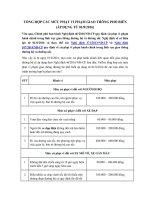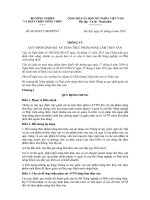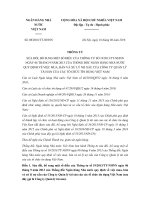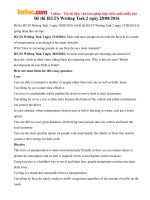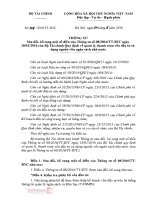Astm f 2158 08 (2016)
Bạn đang xem bản rút gọn của tài liệu. Xem và tải ngay bản đầy đủ của tài liệu tại đây (256.94 KB, 8 trang )
Designation: F2158 − 08 (Reapproved 2016)
An American National Standard
Standard Specification for
Residential Central-Vacuum Tube and Fittings1
This standard is issued under the fixed designation F2158; the number immediately following the designation indicates the year of
original adoption or, in the case of revision, the year of last revision. A number in parentheses indicates the year of last reapproval. A
superscript epsilon (´) indicates an editorial change since the last revision or reapproval.
D2444 Test Method for Determination of the Impact Resistance of Thermoplastic Pipe and Fittings by Means of a
Tup (Falling Weight)
D2564 Specification for Solvent Cements for Poly(Vinyl
Chloride) (PVC) Plastic Piping Systems
D2749 Symbols for Dimensions of Plastic Pipe Fittings
D5033 Guide for Development of ASTM Standards Relating
to Recycling and Use of Recycled Plastics (Withdrawn
2007)3
F402 Practice for Safe Handling of Solvent Cements,
Primers, and Cleaners Used for Joining Thermoplastic
Pipe and Fittings
F412 Terminology Relating to Plastic Piping Systems
1. Scope
1.1 This specification covers the establishment of requirements and test methods for materials, dimensions and
tolerances, flattening resistance and impact resistance of plastic
tubing for use in central-vacuum systems for residential
buildings.
1.2 All notes and footnotes shall be considered as nonmandatory requirements of the specification.
1.3 This specification does not apply to: inlet valve mounting plates of fittings directly connected to these plates, reducer
fittings, mufflers exhaust vents, or flex tubing attached at the
power unit location.
1.4 The values stated in inch-pound units are to be regarded
as standard. The values given in parentheses are mathematical
conversions to SI units that are provided for information only
and are not considered standard.
1.5 This standard does not purport to address all of the
safety concerns, if any, associated with its use. It is the
responsibility of the user of this standard to establish appropriate safety and health practices and determine the applicability of regulatory requirements prior to use.
3. Terminology
3.1 Definitions are in accordance with Terminology F412,
abbreviations are in accordance with Terminology D1600, and
dimension symbols are in accordance with Specification
D2749.
3.2 Definitions of Terms Specific to This Standard:
3.2.1 central-vacuum tubing, n—piping used for centralvacuum systems, that is O.D. controlled.
3.2.2 unaided eye, n—observable without enhancement beyond correction for normal vision.
2. Referenced Documents
2.1 ASTM Standards:2
D618 Practice for Conditioning Plastics for Testing
D1600 Terminology for Abbreviated Terms Relating to Plastics
D1784 Specification for Rigid Poly(Vinyl Chloride) (PVC)
Compounds and Chlorinated Poly(Vinyl Chloride)
(CPVC) Compounds
D2122 Test Method for Determining Dimensions of Thermoplastic Pipe and Fittings
4. Significance and Use
4.1 The requirements of this specification are intended to
provide tube and fittings for central-vacuum cleaning systems,
used to convey debris from the vacuum inlets to the centralvacuum power units.
5. Materials
5.1 Basic Materials—The tube and fittings shall be made of
virgin plastic having a cell classification of equivalent to or
greater than that for poly (vinyl chloride) (PVC) 12454, 13354,
and 12223, as defined in Specification D1784. Compounds that
have different cell classifications, because one or more properties are superior to those of the specified compounds, are also
acceptable.
1
This specification is under the jurisdiction of ASTM Committee F11 on
Vacuum Cleaners and is the direct responsibility of Subcommittee F11.50 on Special
Vacuum Cleaner Types.
Current edition approved Oct. 1, 2016. Published October 2016. Originally
approved in 2001. Last previous edition approved in 2013 as F2158 – 08 (2013).
DOI: 10.1520/F2158-08R16.
2
For referenced ASTM standards, visit the ASTM website, www.astm.org, or
contact ASTM Customer Service at For Annual Book of ASTM
Standards volume information, refer to the standard’s Document Summary page on
the ASTM website.
3
The last approved version of this historical standard is referenced on
www.astm.org.
Copyright © ASTM International, 100 Barr Harbor Drive, PO Box C700, West Conshohocken, PA 19428-2959. United States
1
F2158 − 08 (2016)
TABLE 2 Fitting and Tube Hub Dimensions, in. (mm)
5.2 Recycled Material—The use of recycled materials as
defined in Guide D5033 is acceptable as long as the material
meets the cell classification requirements in 5.1.
Nominal
Size
5.3 Solvent Cement—Where solvent cement is used to join
PVC tube and fittings, it shall meet the requirements of
Specification D2564.
2
6.1 General—The tube and fittings shall be homogeneous
throughout and free of visible cracks, holes, foreign inclusions,
or other defects. They shall be as uniform as commercially
practicable in color, opacity, density, and other physical properties.
6.1.1 Tube and Fitting Flattening—There shall be no evidence of splitting, cracking, or breaking when the tube and
fittings are tested in accordance with 7.4.
6.1.2 Tube and Fitting Impact Strength—The impact
strength of the tube and fittings at the time of manufacture shall
not be less than 20 ft·lbf (27 J), when tested in accordance with
7.5.
7.5 Impact Resistance—Determine the impact resistance of
the tube or fitting in accordance with Appendix X3.5, “Procedure–Specification Requirement,” of D2444. Use either a 6-lb
(2.7-kg) or a 20-lb (9.1-kg) B tup and the flat plate (holder B).
Test six specimens at an impact of 20 ft·lbf (27 J). If all six
specimens pass, accept the lot. If one specimen fails, test
another six specimens. If eleven of twelve specimens pass,
accept the lot. If two or more specimens fail, reject the lot.
8. Retest and Rejection
8.1 If the results of any test(s) do not meet the requirements
of this specification, the tests shall be conducted again in
accordance with an agreement between the purchaser and the
seller. There shall be no agreement to lower the minimum
requirements of this specification by such means as omitting
tests that are a part of this specification, substituting or
modifying a test method, or by changing the specification
limits. In retesting, the product requirements of this specification shall be met, and the test methods designated in the
specification shall be followed. If, upon retest, failure occurs,
the quantity of product represented by the test(s) does not meet
the requirements of this specification.
7. Test Methods
7.1 Sampling—The selection of tube samples shall be as
agreed upon between the purchaser and seller. In case of no
prior agreement, samples selected by a testing laboratory shall
be deemed adequate.
9. Product Marking
7.2 Tube Test Specimens—For testing in accordance with
7.4 and 7.5, cut each test specimen from the selected tube to a
minimum of 6 6 1⁄8 in. (152 6 3.175 mm) in length. Deburr the
edges of each specimen on the inner and outer diameter.
9.1 Tube Marking—The markings shall be applied to the
tube in such a manner that they remain legible after installation.
9.2 Content of Marking—The tube shall be marked at least
every 5 ft (1.5 m) in letters not less than 3⁄16 in. (5 mm) high,
in a contrasting color, with the following information.
9.2.1 The manufacturer’s name (or trademark).
9.2.2 The designation “ASTM F2158.”
9.2.3 Nominal Pipe Size (for example, 2 in. (50 mm)).
9.2.4 The material identification for example “PVC Vacuum
Tubing.”
7.3 Conditioning—For time-of-manufacture testing, conditioning shall be permitted at the ambient temperature and
humidity of the manufacturer’s facility. For referee purposes,
conditioning shall be in accordance with Procedure A of
Practice D618.
TABLE 1 Outside Diameters and Tolerances for Vacuum Tubing,
in. (mm)
9.3 Fitting Markings:
9.3.1 Manufacturer’s name (or trademark).
9.3.2 The designation ASTM F2158.
9.3.3 Nominal tube size.
9.3.4 The material identification symbol, for example, PVC.
Wall Thickness
max
min
min
max
2.005
(50.93)
1.995
(50.67)
0.060
(1.52)
0.070
(1.78)
minA
maxA
OOR
minA
maxA
2.005 2.015 +0.015 1.990 2.000
(50.93) (51.18) (0.38) (50.54) (50.8)
Socket
Wall
Depth, Thickness,
min
minA
OOR
+0.015 0.730
0.085
(0.38) (18.54)
(2.16)
7.4 Tube and Fitting Flattening—Flatten three test specimens between parallel plates in a press until the distance
between the plates is 40 % of the outside diameter of the tube
or fitting. The rate of loading shall be uniform and such that the
flattening is completed within 2 to 5 min. On the removal of the
load, the specimen shall pass if no splitting, cracking, or
breaking is observed under normal light with the unaided eye.
6.2 Dimensions and Tolerances:
6.2.1 Tube Dimensions—The tube dimensions shall meet
the requirements given in Table 1, when measured in accordance with Test Method D2122.
6.2.1.1 Tube Length—The tolerance on the tube length shall
be 61⁄2 in. (612.5 mm).
6.2.2 Fitting and Tube Hub Dimensions—The dimensions
of fittings and tube hubs shall meet the requirements of Table
2 and Fig. 1, when measured in accordance with Test Method
D2122.
6.2.3 Belled Tube—For belled tube fabricated from tube
sections, the thickness of the belled section shall be considered
satisfactory if the bell was formed from tube meeting the
requirements of Table 1.
2
Socket
Bottom-Diameter
A
The wall thickness is a minimum value except that a ±10 % variation resulting
from core shift is allowed. In such case, the average of the two opposite wall
thicknesses shall equal or exceed the value shown in the table.
6. Requirements
Nominal
Tube Size
Socket
Entrance-Diameter
2
F2158 − 08 (2016)
FIG. 1 Typical Fitting Configurations
3
F2158 − 08 (2016)
10. Quality Assurance
11. Keywords
10.1 When the product is marked with this designation,
ASTM F2158, the manufacturer affirms that the product was
manufactured, inspected, sampled, and tested in accordance
with and has been found to meet the requirements of this
specification.
11.1 central vacuum; fittings; PVC; tube
APPENDIXES
(Nonmandatory Information)
X1. STORAGE
X1.1 Outside Storage—Plastic tube should be stored on a
flat surface or supported in a manner that will prevent sagging
or bending. Do not store tube in direct sunlight for long
periods. To prevent damage, fittings should not be stored where
the temperature exceeds 100°F (38°C).
X1.2 Inventories of plastic tube should be used on a first-in,
first-out basis.
X2. JOINTS AND CONNECTIONS
X2.1 PVC tubing and fittings shall be joined by the solventcement method.
X2.2 When connecting to metal tubing systems, metal
tubing and fitting shall be joined in accordance with Appendix
X4.
X3. SOLVENT CEMENT JOINTS
X3.1 Tube Cutting—Cut the tube square with the axis, using
a fine-tooth handsaw and a miter box. A rotary cutter may be
used if the cutting blades are specifically designed for cutting
plastic tube in such a way as not to raise a burr or ridge (flare)
at the cut end (see Fig. X3.1). Remove all burrs with a
deburring tool, knife, file, or abrasive paper.
X3.2 Dry Fit Test—The solvent cement joint is designed so
that there will generally be interference of the tube wall with
the fitting socket before the tube is fully inserted. Insert the
tube into the fitting and check that the interference occurs about
1⁄3 to 2⁄3 of the socket depth (see Fig. X3.2).
FIG. X3.2 Tube Entering Dry Fitting
FIG. X3.1 Apparatus for Cutting Tube
4
F2158 − 08 (2016)
The surface temperature of the mating surfaces should not
exceed 110°F (43°C) at the time of assembly.
X3.3 Cleaning—Surfaces to be joined must be cleaned and
be free of dirt, moisture, oil, and other foreign material. If this
cannot be accomplished by wiping with a clean, dry cloth, a
chemical or mechanical cleaner must be used. If a chemical
cleaner is used, apply with an applicator. (Warning—Skin
contact with chemical cleaners should be avoided.)
X3.4.3 Apply cement lightly but uniformly to the outside of
the tubing, taking care to keep the use of cement to a minimum.
(Warning—Application of cement to fitting socket is not
recommended and can cause drippings or an excess amount of
cement to be pushed to the inside diameter of the connection
that can possibly snag debris and eventually create a clog.)
X3.4 Application Procedure
X3.4.1 Handling Cement—Keep the cement can closed and
in a shady place when not actually in use. Discard the cement
when an appreciable change in viscosity takes place or at the
first sign of gelation. The cement should not be thinned. Keep
the applicator immersed in cement between applications.
X3.4.4 Low-Temperature Applications—At temperatures
below freezing, 32°F (0°C), solvents penetrate and soften the
PVC surfaces more slowly than in warmer weather. For this
reason, it is recommended that testing be done on a piece of
scrap tube to determine if satisfactory penetration of the
surfaces can be achieved.
X3.4.2 Application of Cement—PVC solvent cement is fast
drying, and, therefore, the cement shall be applied as quickly as
possible, consistent with good workmanship (see Fig. X3.3).
X3.4.5 Assembly of Joint—Immediately after applying a
coat of cement to the tube, forcibly insert the tube into the
socket. To distribute the cement evenly, turn the tube or fitting
a 1⁄4 turn during the process (see Fig. X3.4).
X3.4.6 Assembly should be completed within 20 s after the
application of cement. (Warning—Until the cement is set in
the joint, the tube may back out of the fitting socket, if not held
in place for approximately 1 min after assembly. Care should
be taken during assembly not to disturb or apply any force to
the joints previously made, as early rough handling can destroy
fresh joints.)
X3.4.7 See Practice F402, “Practice for Safe Handling of
Solvent Cements, Primers and Cleaners Used for Joining
Thermoplastic Pipe and Fittings.”
FIG. X3.3 Uniform Application of Cement to Outside of Tube
5
F2158 − 08 (2016)
FIG. X3.4 Assembly of Joint
X4. METHODS OF JOINING METAL TUBING AND FITTINGS
X4.3.3 Shrink Sleeve—A heat shrinkable polyolefin band
literally shrinks and encircles the connection, thus giving it
mechanical strength and a positive seal. This joining method
can be used in conjunction with slip couplings, expanded
tubing, or fittings. Depending on weather conditions, shrink
sleeves typically can be installed in as little as 1 to 2 min each.
(See Fig. X4.2.)
X4.3.3.1 Equipment Needed to Apply Shrink Sleeve:
(1) A propane or butane torch having a broad 12-in. or
15-in. billowy orange flame.
(2) Or a commercial heat gun with 500°F (14 amp)
capability.
X4.3.3.2 Applying Shrink Sleeve:
(1) Slip shrink sleeve over the clean tube before joining
fittings together, join fittings and center shrink sleeve over joint
area.
(2) Apply heat, starting in center over joint and work
towards ends—applying heat as uniformly as possible around
the circumference of the sleeve.
(3) Operation is complete when the sleeve is in 360 degree
contact with the tube and small amount of molten adhesive is
visible at both ends of sleeve.
(4) The joined connection may be moved when the sleeve
and joint area are cool enough to hold with bare hands.
(5) For repair—simply cut the sleeve with a knife or razor
blade and remove.
X4.1 Tube Cutting—Cut the tube square with the axis, sing
a metal cutting blade in cutting blade in chop saw or band saw.
A rotary cutter may be used if the cutting blades are specifically
designed for cutting metal tube in such a way as not to raise a
burr or ridge (flare) at the cut end. Remove all burrs with a
deburring tool, file, or abrasive paper.
X4.2 Cleaning—Surfaces to be joined must be cleaned and
free of dirt, moisture, oil, and other foreign material. If this
cannot be accomplished by wiping with a clean, dry cloth, a
chemical or mechanical cleaner must be used. If a chemical
cleaner is used, apply with applicator. (Warning—Skin contact
with chemical cleaners should be avoided.)
X4.3 Assembly of Joint—There are three popular and recommended methods of joining metal tubing and fittings for use
in low vacuum and pressure systems under 16 psig (Adhesive,
Compression Couplings and Shrink Sleeves). All of these
methods provide secure connections eliminating the need for
welding or brazing.
X4.3.1 Adhesive—The best proven adhesive to bond metal
tubing and fittings together is industrial contact cement. For
best results, apply coatings of equal thickness on each clean
surface to be joined. Do not join immediately. When both
surfaces are tacky to the touch, insert the tubing full depth into
the fitting socket. Make sure excess adhesive has not been
pushed to the inside diameter of the tubing (if any has, be sure
to remove it to prevent any future obstruction areas).
X4.4 Tubing Support—All horizontal runs of the system
must be securely supported and fastened with tube hangers.
Hangers should be spaced on 10-ft centers. All vertical tubing
must be firmly held in place.
X4.3.2 Compression Coupling—A mechanically fastened
coupling that connects straight end tubing of fittings within the
ID of coupling. These couplings offer an easy “tear down” or
“repair” function. (See Fig. X4.1.)
FIG. X4.1 Compression Coupling
6
F2158 − 08 (2016)
FIG. X4.2 Shrink Sleeve
FIG. X4.3 Improved Compression Coupling
X5. SYSTEM INSTALLATION
(j) Side cutters
(k) Hammer
(l) Wire coat hanger
(m) Pocket or utility knife
(n) Flashlight
(o) Drywall saw or jig saw
(p) Deburring and chamfering tool for PVC tubing
(q) Electrical tape
(r) Propane or butane torch
(s) Safety gloves
(t) Wire snippers
X5.1 To determine the location of hose inlet-valves, identify
locations that will provide the maximum area of cleaning
coverage, usually on inside walls in hallways, near doorways,
archways, and at the bottom of stairways. (Warning—
Installation of a tubing system will vary depending on the
architecture of the building; however, some features are common and are addressed. Other features are referenced in the
Manufacturer’s installation instructions.)
X5.1.1 After locating the hose inlet-valve, (unless the hose
is shorter), use a 30-ft (9.1 m) length of cord or string to ensure
that the maximum area of cleaning coverage is accessible.
Drawings or plans may be used as well as the actual building.
Floor plans are normally 1⁄4 in. scale (1:50 cm). A 7 in. (180
mm) piece of string or beaded chain will help determine the
optimum location. Keep in mind that furniture, doors, and
other obstacles will prevent hoses from reaching the maximum
30 ft (9.1 m), so valve placement and quantity is important to
ensure that all areas to be cleaned can be reached by the hose.
X5.3 Installation of Hose Inlet Valves:
X5.3.1 The hole in the wall for the hose inlet-valve should
be located between studs, clear of obstructions such as
plumbing, wiring, and heat ducts.
NOTE X5.1—The minimum stud depth for sufficient clearance of an
adapter elbow is 23⁄4 in. (70 mm).
X5.1.2 Check the tubing path to avoid possible obstructions,
such as heating ducts. Installation is best accomplished by
running a trunk line leading from the farthest inlet valve to the
power unit with branch lines running to the individual valves.
Lines may be installed in partitions, attics, and crawl spaces,
under or between floor joists, or on faces of walls or columns.
It is always best to keep trunk lines and branch lines as straight
as possible without unnecessary bends and turns.
X5.3.2 Determine the exact location of the hose inlet-valve
and select a point on the floor directly below vertical center of
the desired location. Drill a small hole (against the wall)
through the flooring and subflooring. The straight section of a
coat hanger cut at an angle makes a good pilot hole drill bit.
From beneath the floor, this pilot hole will serve as a guide
point from which you can measure over approximately 21⁄2 in.
(63 mm) to locate and drill a 21⁄4 in. (57 mm) diameter hole in
the center of the sole plate. If it is a slab construction,
additional planning will be required to come down from the
attic area.
X5.2 Recommended Tools:
(a) 1⁄2 in. (1.3 cm) right angle drill or 1⁄2 in. (1.3 cm) drill
(b) 21⁄4 in. (5.7 cm) hole saw or cutter
(c) 1⁄4 in. (6.4 mm) masonry drill bit
(d) Common hacksaw or small handsaw with 18 teeth/in.
blade or 2 in. PVC tube cutter
(e) Miter box
(f) Steel measuring tape
(g) Screwdriver (Phillips)
(h) Screw driver (slot)
(i) Wire connectors for #20 AWG (min) wire
X5.3.3 Before cutting the hole in the wall for the mounting
bracket, drill the 21⁄4 in. (57 mm) diameter hole up through the
sole plate and, using a flashlight, inspect the interior of the wall
to be sure there are no obstructions.
X5.3.4 Having determined that there are no obstructions in
the wall, cut a hole for the mounting bracket using a single
blade drywall saw or jig saw.
7
F2158 − 08 (2016)
X5.4.5 Low-voltage wire must follow the tubing system. At
the junction of a branch line and the trunk line, the wires must
be spliced together. Each inlet valve must be able to activate
the power unit independently of the other valves. The wire
shall be attached to the tubing with supplied clips, cable ties, or
electrical tape, at least every 4 ft (122.4 cm).
NOTE X5.2—Refer to the manufacturer’s installation manual for confirmation of hole size required for mounting brackets and hose inletvalves.
X5.3.5 The end of the tubing is passed up through the hole
in the sole plates so as to be visible to the hose inlet-valve
opening.
NOTE X5.3—At this point, follow the manufacturer’s instructions, as
different valves will have different methods of attachment and wiring
instructions.
X5.5 Fire Penetrations—Where required, fire penetrations
shall be installed in accordance with the local building-code
requirements.
X5.4 Power Unit Connections
X5.4.1 Power units are to be wall mounted approximately
28 in. (71.12 cm) from the floor with a minimum clearance of
6 in. (15.25 cm) from the ceiling, sidewall, or any obstruction,
so as to facilitate motor cooling.
X5.6 Testing
X5.6.1 Take the vacuum hose and insert it in the farthest
valve. The power unit should start automatically. If the
assembly has a low-voltage switch, ensure the switch is in the
on position.
NOTE X5.4—Dimensions may vary from manufacturer to manufacturer.
X5.4.2 Piping connections to the inlet side of the power unit
are fastened with hose clamps and flexible couplings or solvent
cemented to a mechanically attached adapter.
X5.6.2 Remove the hose and the power unit should shut off.
X5.4.3 Attach the low-voltage #20 AWG (min) wires to the
low voltage terminals of the power unit, using the specific
terminals supplied by the manufacturer.
X5.6.3 While the hose remains in the inlet valve, check the
other inlets for air tightness. The sound of a hiss indicates an air
leakage. By either loosening or tightening the inlet-valve
mounting screws, the leakage may be corrected.
X5.4.4 Connections to the exhaust side of a power unit shall
be the same as described in X5.4.2.
X5.6.4 Remove the hose from the inlet valve and repeat
X5.6.1 – X5.6.3 for each remaining outlet.
ASTM International takes no position respecting the validity of any patent rights asserted in connection with any item mentioned
in this standard. Users of this standard are expressly advised that determination of the validity of any such patent rights, and the risk
of infringement of such rights, are entirely their own responsibility.
This standard is subject to revision at any time by the responsible technical committee and must be reviewed every five years and
if not revised, either reapproved or withdrawn. Your comments are invited either for revision of this standard or for additional standards
and should be addressed to ASTM International Headquarters. Your comments will receive careful consideration at a meeting of the
responsible technical committee, which you may attend. If you feel that your comments have not received a fair hearing you should
make your views known to the ASTM Committee on Standards, at the address shown below.
This standard is copyrighted by ASTM International, 100 Barr Harbor Drive, PO Box C700, West Conshohocken, PA 19428-2959,
United States. Individual reprints (single or multiple copies) of this standard may be obtained by contacting ASTM at the above
address or at 610-832-9585 (phone), 610-832-9555 (fax), or (e-mail); or through the ASTM website
(www.astm.org). Permission rights to photocopy the standard may also be secured from the Copyright Clearance Center, 222
Rosewood Drive, Danvers, MA 01923, Tel: (978) 646-2600; />
8

